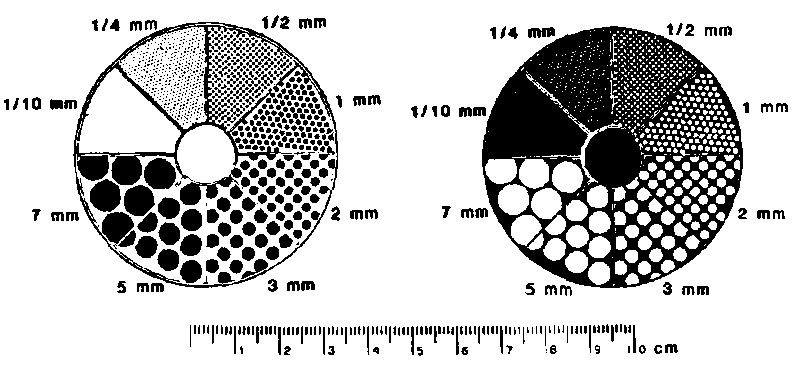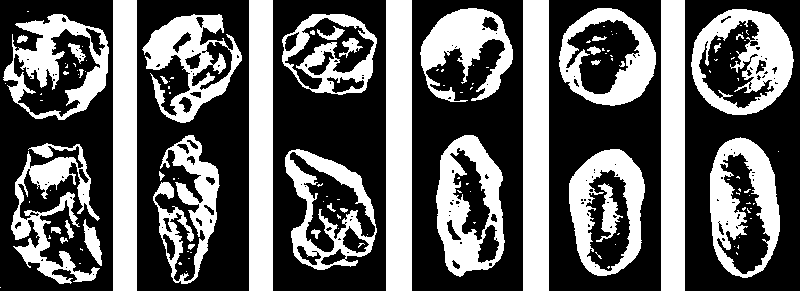BACKGROUND:
The Rock Cycle creates new rocks and destroys pre-existing rocks. Sand is
an example of this. Sand is a kind of rock in transition. Sand grains form
from a pre-existing rock that was destroyed by weathering and erosion. Sand
grains become a sedimentary rock when they are cemented together. In this
lab, students will look at four key characteristics of sand including
composition, grain size, grain roundness, and sorting.
Since sand comes from a "mother" or source
rock, it is possible
to determine what type of rock produced the sand or "baby rocks."
This is because the composition and general color of both the
"baby" and "mother" rock are often very similar. The
students will use this concept in the lab to identify sand samples and their
potential "mother" rocks.
For example, the plutonic igneous rock granite is largely composed of the
minerals quartz, feldspar, mica, and hornblende (a dark colored iron- and
magnesium-rich mineral). When a granite weathers, two types of sand can form
composed of granite rock fragments or individual loose minerals. In the case
of granite, these crystals might be quartz, feldspar, mica, and hornblende.
Therefore, sand composed of a mixture of granite fragments, quartz, mica,
and feldspar was probably from a granite source area. Hornblende and mica
weather very quickly, so most sand derived from granite is mostly quartz and
feldspar.
Three textures are relevant to this lab including grain size, grain
roundness, and sorting. Grain size is the size of the particles, measured by
grain diameters. "Sand-sized" in this sense is defined as
particles from 1/16 to 2 mm in diameter.
Grain roundness is the presence or absence of corners and sharp edges on
the particle. Particles with many edges are "angular". Particles
lacking edges are "rounded". Note that roundness is not the same
as spherical. An oblong particle can also be highly rounded.
Sorting is the range of grain sizes in a sand. Poorly sorted sands show a
wide range of grain diameters, well-sorted sands have similar sized grains.
As sand grains are transported by wind, water or whatever process, the grain
size tends to decrease, roundness increases, and sorting increases.
Determining these textural properties is a very visual process. Students
should learn to be active observers.
PROCEDURE:
- Make sure you are familiar with the "Sand Identification
Chart" that the students will be using.
- Students should describe the grain size, roundness, sorting, and
composition of each sand sample.
SIZE: You have two circles with dots that are the size that is
written along the outside of the circle. There is a dark circle and a
light one...only because light sands are seen lighter backgrounds. Have
them sprinkle a little on the paper and find the size that the particles
fit into. In most cases their will be a range of sizes. Size just tells
you how long a particle has been eroding...the longer it has been moving
around the smaller it will be in general.

ROUNDNESS: Have the students compare the particles in
their sand with the pictures of roundness. You might need a magnifying
glass...but a little imagination is fine. The rounder a particle, the
longer it has been moving. In the diagram below the most rounded are on
the right, the most angular is on the left.

SORTING: Sorting refers to the range in size of
particles. If a sample has big and little pieces it is not well sorted,
but if all the particles were of the same size it would be very well
sorted. Sorting is due to how the sand particles settled down...if it
was turbulent sand would not be well sorted, if in a quiet setting it
would be well sorted. Also, wind can carry small particles to areas on a
beach that are controlled by the wind, like dunes, and these tend to be
well sorted. In the diagram below poorly sorted is on the right, and
well sorted is on the left.

-
An alternative method can be used if you have
microscopes. Use tape to hold a few particles in place under the
objective. You can also have students use round Avery labels and
"pat" the sticky side on the sand. Then glue the other side on
an index card and view it under the microscope. Make sure students label
the sand. If you have the Swift GH microscope, you can keep the sand in
the bag and have the students observe the sand through the bags. Have
the students illustrate their observations. In most cases, the students
will see a range of sizes.
-
Included in the kit are mineral samples of quartz and feldspar.
These two minerals are very abundant and very common in sands throughout the
world. They are hard minerals, so tend to remain after all the erosion.
-
Have the students determine the mother rock(s) for
each sand sample. They can best do this by matching the minerals and
rock fragments in the sand samples to the possible mother rock samples
on display.
Here is basic information on each source rock in the
lab. Samples of each rock should be available to the students as they
work on the lab:
CHERT (sedimentary) - A rock that is composed
of quartz formed from recrystallized microscopic skeletons of
radiolarians (protozoa). If you look under the microscope, you can see
very small spots in the rock. These are the radiolarians. Radiolarians
are only about 150 microns in diameter, so you cannot see much detail.
Chert is very hard, and comes in many colors. Chert forms in deep
ocean environments, and becomes a source rock when it is uplifted
above sea level by mountain building.
BASALT (igneous) Basalt is a dark, fine
-grained igneous rock. It forms during volcanic eruptions from magma
that cooled relatively quickly (in days to weeks). Minerals can be
seen under a microscope (transmitted light).
GRANITE (igneous) - A plutonic igneous rock
that formed when molten magma slowly cooled inside the earth. It
occurs in varying shades of light and dark colors depending on the
specimen’s mineral composition. The minerals in granite can be seen
without a microscope.
SERPENTINITE (metamorphic) - This rock is the
"state rock" of California. It has a mottled green color and
a "scaly" appearance. This metamorphic rock is formed in
areas that have been under high pressure and low temperature, and is
often associated with convergent plate boundaries.
-
ANSWERS:
MONTARA = light color, .1-7mm, very poorly
sorted, subrounded, mother rock =granite;
RODEO BEACH = dark color, .1-7mm, poorly
sorted, angular-rounded, mother rocks = chert, serpentinite, basalt
HALF MOON BAY = light color, 0.23-3 mm, poorly
sorted, subangular, mother rock = granite
BODEGA BAY = dark color, .1-1mm, well sorted,
subangular-subrounded, mother rock = basalt
|